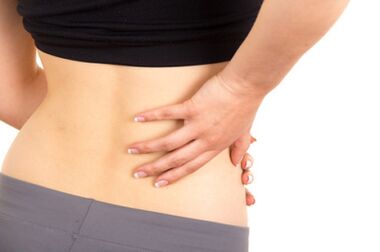
Many people ask this question due to the fact that the lower back is most often subjected to extreme lifelong loads of a person.In many cases, this provokes the appearance of osteochondrosis or exacerbates its condition.If you start this disease, it can become a serious problem, so it is so important to have a diagnosis on time and start treatment.In the article you will find all about what this disease is, what its causes and symptoms are, as well as the treatment of the disease.
Reasons
The main causes of lumbar osteochondrosis are:
- flat legs;
- scoliosis;
- mechanical injuries to the lower back;
- metabolic disorder;
- A sedentary lifestyle;
- obesity;
- violation of the balance of water-salt;
- malnutrition;
- Pregnancy.
Important!The causes of the lumbar problems have not been fully studied.This means that in a particular situation it can be difficult to determine exactly what provoked the onset of the disease.
Symptoms
There are several subspecies of osteochondrosis, so the symptoms of the disease can vary slightly.We will then analyze each subspecies and characteristic signs.
Polysegment - What is it?
Polish osteochondrosis (PSO) is a defeat of several segments of the spine at the same timeDegenerative processes.
Signs:
- Severe pain in the lumbar region.
- With sharp movements or attempts to raise something heavy, "photos" appear.
- It becomes difficult to perform the usual motor actions.
Convexity
Protency is one of the stages of osteochondrosis, during which the elasticity and height of the intervertebral discs decreaseSAs a result, the cartilage begins to gradually descend beyond the boundaries of the vertebrae.
Signs:
- suturing pain that can occur not only when movement but also at rest;
- easy numbness of the lower limbs;
- Parash or redness of the skin of the lower limbs;
- the appearance of weakness in the legs;
- Long sitting or standing causes a pain that disappears after the posture change;
- When you raise heavy things, acute pain can be applied to the pool and thighs.
Intervertebral disc hernia L5-S1
The appearance of hernia is the last stage of osteochondrosisSThis problem is characterized by a strong convexity and loss of the intervertebral disc, which does not withstand the pressure of the vertebrae that surrounds it.
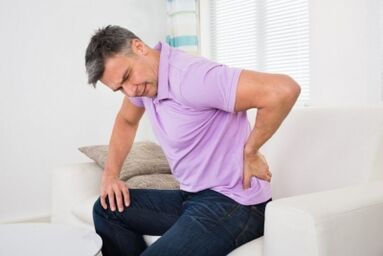
Signs:
- Pain syndrome that is applied not only to the lower back but also to one of the lower limbs.
- The appearance of pain in one of the ass and leg associated with it.
- Strong numbness or tingling in the lower limbs.
- Strengthening the numbness and pain in the vertical position and during movement.
- Reducing the amplitude of movements in the lower back.
- Leg Syndrome.
- Changing gait and stand.
- Strong pale or redness of the skin in the lower back and on the legs.
- In rare cases, urine or stool occur.
Psychosomatics in women and men
Psychosomatic disorders occur due to emotional injuries sufferedSThe signs of this disorder depend on the stage of osteochondrosis and do not differ from the above.
Important!When a psychosomatic disorder occurs, the patient should be treated with a neuropathologist and a psychotherapist in order to achieve maximum positive effect.
Do they take the army with a diagnosis?
Lumbar osteochondrosis belongs to the expiry category "B"SThis means that the young man has serious health problems that do not allow him to suffer military service.In order to get this category, the young man must have the following deviations:
- intervertebral hernia;
- severe pain from exercise;
- Noticable to X -Ray deformation of the vertebrae and intervertebral discs.
Stages
Lumbar osteochondrosis has 4 stages(Or, as they are also called - grade: 1, 2, 3 and 4), each of which is characterized by certain degenerative processes.
Degenerative changes at any stage
- 1-2 stageSIn stage 1, a fibrous ring is deformed due to the displacement of the internal release of the nucleus, which is more strongly manifested than normal.In 2 stages, a crack on the fibrous ring appears, leading to instability of the spinal segment.
- 3-4 stagesSIn 3 stages, the intervertebral disc is completely cracked, resulting in a disc loss.A dystrophic lesion of the intervertebral disc and spondylosis appears in 4 stages.
Diagnostics
In order to make an accurate diagnosis, the doctor must conduct a number of tests that include:
- Primary verification (palpation, visual check, check on the level of physical activity).
- Radiography.
- Computed tomography (CT).
- Magnetic resonance imaging (MRI).
ReferenceSAmong all diagnostic methods, MRI is considered to be the most modern and effective.The problem is that such a device is not in every hospital and most often MRI should be done in private clinics or wait long for your order.
The different stages and varieties of lumbar osteochondrosis have their own characteristics, so their shades have their diagnosis.
Rooted
Usually Rooster syndrome occurs in the last two stages of the disease.The syndrome is characterized by damage to the nerve roots that emerge from the spinal cordSThey innervate and control the functioning of the muscles in the lower back, the genological system and the intestines.Therefore, spinal syndrome in the lumbar region leads to problems with these systems.
Communication with the deformation of the intervertebral disc
Rooser syndrome occurs in the last stages of osteochondrosis due to the leveling of the intervertebral disc and squeezing the nerve roots with vertebrae.MRI is most suitable for diagnosing this disorder as this procedure allows you to see all changes in soft tissues.
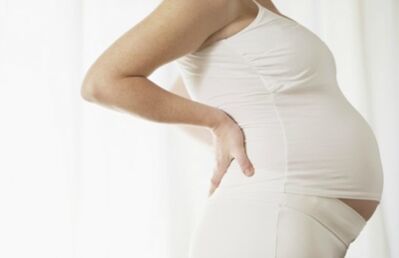
During pregnancy and lactation
If a woman leads a sedentary lifestyle, suffers from flat feet or has a genetic predisposition, the likelihood is increased that she will have osteochondrosis during pregnancy.
For pregnant women, this disease is dangerous not only by pain attacks but also from the fact thatThis may lead to a decrease in pelvic bone sizeSCaesarean section will therefore be required.
Unfortunately, to diagnose osteochondrosis with the help of MRI, CT or X -shirt, it is prohibited during pregnancy.Therefore, treatment is prescribed empirically.If a woman has already given birth but still feeds her breasts, the hardware diagnostics method is also contraindicated.
Convex
When a protrusion of the intervertebral disk appears, the X -s will not be able to show great resultsbecause the deformation occurs only with a fibrous ring and a core.
A MRI study is needed, which scans the soft tissues exactly and can reveal various degenerative changes.
Complications and consequences
If you do not treat lumbar osteochondrosis, it can lead to the worsening of the health and the development of other diseases.
Why is the disease dangerous?
In 4 stages of the disease, such irreversible changes begin to appear as:
- Disruption of spinal circulation.
- Problems with intestinal emptying.
- Reducing sensitivity in the groin and anus.
- Weakness in the lower limbs.
- Frequent urination.
- Paralysis of the lower limbs.
- Reduction of mobility in the lower back.
- Spasmodic muscles of the lower back and legs.
Concomitant diseases
- radiculitis;
- compression and vascular ischemia;
- compression myelopathy;
- sciatica;
- Lumbago.
Treatment and rehabilitation
Now that you know what disease this is, we will talk about how to treat it.After diagnosticsThe doctor prescribes a course of treatment depending on the stage and form of osteochondrosisS
Orthopedic devices for the lower back
To reduce the pain syndrome and muscle tension in the lower back, the patient is suggested to wear a special orthopedic corset.
It covers the entire lower back, maintaining the muscles, vertebrae and connections in the correct position, eliminating excessive tension from them.
Medication
Medicines are one of the important aspects of lumbar osteochondrosis therapy.Usually 5 groups of drugs are usedSIn normal mode, this can be ointments or tablets.If the patient is overtaken by severe pain attacks, a drug blockade is performed.

Medication
The main groups of osteochondrosis drugs:
- PainkillersIn the form of tablets or ointments.
- Anti -inflammatorySIt is also used in the form of tablets or ointments.
- Monsolelaxants- Medicines that reduce muscle spasm.
- Chondroprotectors- Medicines that restore bones and cartilage.
- VitaminsSIn general, group B is used for osteochondrosis, so they help to improve the metabolic processes in the affected tissues.
Do not try to choose medicines yourself.All medicines should only be prescribed by the doctor.
Blockade of medication
The blockade is the introduction of drugs using a syringe directly into the affected area of the spine.This is necessary when it seems that acute pain syndrome reduces discomfort and restores the usual level of physical activity of the patient.
Physiotherapy
Physiotherapy methods are often used to restore spasmodic muscles and the affected tissue of the lower back.Magnetotherapy is particularly up -to -date among themS
Magnetotherapy
This procedure stimulates metabolic processes, blood circulation, improves the function of the endocrine and nervous systems.The method can be very painful but quite effective.
You can improve the patient's condition with magnetotherapy for 3-4 weeks.
Massage
Massage relieves pain and muscle spasm.It is performed only by a specialist in medical education.Most often, a course for 10-12 sessions is prescribed.The final decision on the duration of therapy is taken by the massage therapist.
Guide and Acupuncture
Manual therapy eliminates pain and increases the volume of movements in the lumbar regionSThis is due to the improvement of the biomechanics of the musculoskeletal system, blood circulation and metabolic processes.Acupuncture has a similar effect, but it has a significant effect on the affected areas of the muscles.
Therapeutic gymnastics
Exercise therapy is one of the most effective ways to combat the unpleasant effects of osteochondrosis for the vertebrae.Before you start hours, consult an exercise therapy instructor.
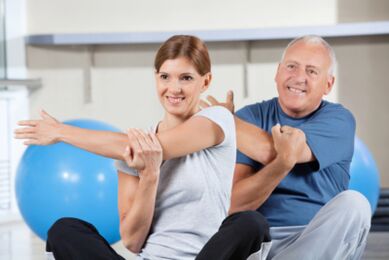
What can and cannot be done?
During exercise therapy is prohibited:
- Make sharp movements;
- Significant bend in the lower back;
- Sharply increase the movement amplitude.
In exercise therapy is allowed:
- Make smooth movements;
- Use inventory (benches, gymnastics, dumbbells);
- Do exercises for the flexibility of the lumbar region.
Doctor
The doctor has developed a methodology for his inflammation spine.When he realized that his exercises had a positive effect on the inflamed back, he began to share them with his patients.
Following are the three simplest and most effective exercises in gymnastics:
- For a warm -Up: Put fours and walk in this position around the room for 5-7 minutes.Pre -lived knees with protective dressings.
- The main exerciseSStanding on fours, bend in breath.Bend your back on exhalation.Repeat 5-8 times.
- StretchSStanding on fours, go back smoothly, touching the ass of the heels.Repeat 3-4 times.
Yoga and Pilates
Pilates was designed specifically for recovery of pilots who have suffered back injuries so that the system works perfectly with spinal osteochondrosis.It is necessary to be included in this system only under the supervision of an instructor.
Yoga has many instructions, and also suitable for working with a sick spine.
Such classes are only allowed during the remission period as they have high intensity.
Folk remedies at home
Preparing an ointment at home
You will need:
- coconut oil - 50 g;
- Beeswax - 2 s.L.;
- Camphor - 1 s.L.;
- Mint essential oil, arnica and cloves.
How to cook:
- Mix coconut oil, beeswax, camphor and heat the mixture in the microwave for 1 minute.
- Add 9 drops of mint, 7 drops of arnica and 5 drops of clove oil, then mix the mixture.
- Place the ointment in a glass jar for storage.
FinishedRub the lower back 2 times a day with ointmentuntil the pain is reduced.
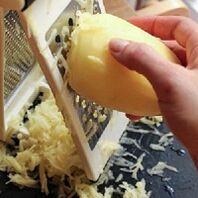
Honey and potato compress
You will need:
- 50 g copper;
- 1 large potato.
Grind the potatoes to a large grater, mix with honey and grate your back with a mixture.Put the wax paper on top and wrap the lower back with a warm cloth.The compress should be left overnight.Repeat the procedure until the back pain passesS
Ginger
You will need:
- ground ginger - 2 tsp;
- honey - 1 tsp;
- Carkuma Ground - 1 tsp;
- Black pepper - 0.5 tsp
Carefully mix all the ingredients and apply a thin layer of ointment on your back.Apply warm fabric on top.If it burns strongly, gently rinse the ointment with warm waterS
Herbs
You can use the following herbs:
- Chamomile pharmacy;
- dill;
- Air;
- thyme;
- A sage.
Mix 20 grams of all plants and prepare a healing decoction.When you bathe, add a finished decoction to it.You can use this recipe 1-2 times a week.Herbs relieve tension and pain in the lower backS
Surgery
This method of treatment is used in rare cases if conservative treatments are ineffective.During the operation, the part of the cartilage that exceeds the vertebrae is removed.
If the intervertebral disc is damaged too much, it is replaced by artificial.
Forecasts
The prognosis can only be given by the attending physician as each person meets individuallySIt all depends on the neglect of osteochondrosis and the general condition of the patient's body.
What to do with exacerbation?
During the deterioration period, it is necessary to exclude all physical activity, to use medicines and to wear a dressing of the warming waist.In addition, you should consult your doctor, who will make more detailed recommendations.

Prevention
How to prevent chondrosis?
As you cannot affect genetic abnormalities and hereditary predisposition, it will not work completely to prevent chondrosis.
ButIn your strength to monitor the correct regimen of the day and nutrition, show more physical activity and abandon bad habits.
All these tips will help maintain the health of the spine as long as possible.
Sickness
The neuropathologist prescribes sick leave only with an exacerbated form of the disease, accompanied by severe pain, which usually begins at 2 and 3 stages of osteochondrosis.
How many days do they give?
As a ruleLumbar osteochondrosis relaxation is given no more than 7 daysS
Specialists' tips
If you notice the first signs of discomfort in the lower back, when you lift something heavy or just with active movements and twisting, do not tighten yourself with diagnosis.
The earlier you start treatment, the easier it will be to deal with the disease and avoid unpleasant health effects.
Many are accustomed to perceiving lumbar osteochondrosis, as provided.But this disease can progress, which will eventually have many unpleasant consequences for the patient.Remember that you are responsible for your health, not for doctors and if you find signs of osteochondrosis, start treatment as quickly as possible.
























